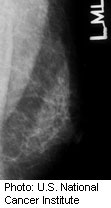
FRIDAY, April 29 (HealthDay News) — Patients with early stage breast cancers are commonly treated with surgery or surgery plus radiation, and radiation is widely believed to cut local recurrence rates by about half.
Now, researchers report that they have found that surgery plus radiation does cut local recurrences, but appears to increase the risk of invasive breast cancers later.
“I don’t want people to think radiation is bad,” said study author Dr. Janie Weng Grumley, a fellow in breast oncology at the University of Southern California Keck School of Medicine. “We know there is less recurrence with radiation.”
Grumley’s team evaluated 1,014 patients with early breast cancer, known as ductal carcinoma in situ. Of these, 651 had surgery alone while 363 had surgery plus radiation.
The 10-year probability of any recurrence at the same site was 30 percent for the surgery group and 18 percent for the combination group. However, when cancer does return in those who get the combination treatment, her study showed the patterns are different.
“The patients who got radiation recurred a lot later than the patients who didn’t,” she said. The average time to the cancer recurring in the same site was 7.5 years for those who had radiation plus surgery and 4.4 years for those who had surgery only.
However, “surgery plus radiation had more invasive recurrence,” she said. Thirty-seven percent of the surgery group had an invasive recurrence at the same site, but 57 percent of the combination group did, she said.
While 28 percent of the recurrences were in different quadrants of the breast for the combination patients — essentially new cancers — only 10 percent of the recurrences in surgery-only patients were in new quadrants.
The survival rate among the surgery group at 10 years was 99.7 percent, compared to 98.3 percent for the combination group, the study found.
The study leaves many questions unanswered. “Is the radiation causing more new cancers?” Grumley wondered.
The research also has several limitations: The average follow-up for the surgery group was six years, while the average follow-up for the combination group was a little over nine years. “One could say the follow-up is longer, and maybe we would find the same thing if we followed the surgery-only group,” Grumley said.
The findings were slated to be presented Friday at the American Society of Breast Surgeons meeting, in Washington, D.C.
The finding should be considered very preliminary, said Dr. Otis Brawley, chief medical and scientific officer for the American Cancer Society and professor of oncology and epidemiology at the Emory University School of Medicine, in Atlanta.
“I would say you have to look at all abstracts from scientific meetings with a grain of salt,” Brawley said. The research has not yet been exposed to rigorous review and critique by the researchers’ colleagues, he said. If a study is the first of its kind, it must be replicated by others to confirm the finding.
Grumley said the message for now is that women should be aware of the different patterns found. “Really, the message should be we should monitor these patients beyond the [typical] five years,” she added.
More information
To learn more about ductal carcinoma in situ, visit the U.S. National Institutes of Health.

